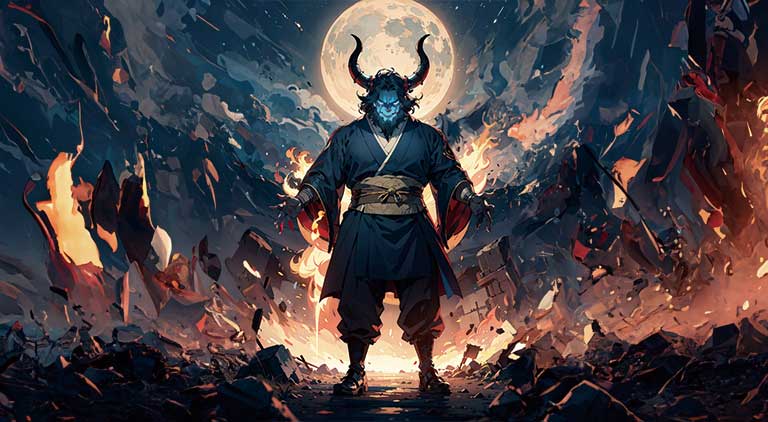1. Introduction: The Enigmatic Legend of Ryomen Sukuna
Japan’s folklore is rich with tales of supernatural beings known as yokai – creatures that blur the line between myth and reality. Among these legendary figures stands Ryomen Sukuna, Japan’s strongest yokai, known for his two-faced, four-armed appearance. Was he a fearsome rebel or a heroic guardian? This question has intrigued historians and storytellers alike for centuries. Join us as we unravel the mysteries of Ryomen Sukuna, a figure whose legacy oscillates between fear and reverence.
2. Who Was Ryomen Sukuna? A Historical Perspective
Ryomen Sukuna is said to have appeared during the reign of Emperor Nintoku in the 5th century, in Hida Province (modern-day Gifu Prefecture, located in central Japan). His description in historical texts is both striking and unusual:
- Two Faces: One facing forward, the other backward
- Four Arms and Four Legs: Two sets of limbs for enhanced agility
- Weapon Mastery: Wielding two swords and two bows simultaneously
- Missing Anatomical Features: Lacking a proper neck and having incomplete knees and heels
According to the Nihon Shoki (Chronicles of Japan), Ryomen Sukuna defied imperial authority, looting villages and causing unrest. He was ultimately defeated by Naniwa no Neko Takefurukuma, a general dispatched by the emperor. However, regional legends tell a different story.
3. Local Legends: Hero or Villain?
In Hida Province and the surrounding regions, Ryomen Sukuna is celebrated as a hero who protected the local population and contributed to cultural and spiritual development.
3-1. The Dragon Slayer of Takayama
In Takayama City, Ryomen Sukuna is remembered as a divine warrior who slew a poisonous dragon that terrorized the region. This act of bravery earned him the status of a protector of the people.
3-2. The Temple Builder
The records of Senkoji Temple describe Ryomen Sukuna as a manifestation of Kannon, the Buddhist deity of compassion. He is said to have discovered sacred artifacts and laid the foundation for spiritual practices in the region.
3-3. Guardian of the Mountains
Legends from Mt. Kurai depict him as a guardian who defeated the demon Shichina to ensure peace for mountain villages.
These stories paint a picture of a figure deeply intertwined with the local identity, revered for his strength and righteousness.
4. Theories Behind the Myth
4-1. Political Symbolism
Historians suggest that the depiction of Ryomen Sukuna as a monster might reflect the political resistance of the Hida clans against the central Yamato Court. The exaggerated features could symbolize the “otherness” of those who resisted imperial rule.
4-2. Archaeological Findings
In 2006, a two-faced clay figurine was unearthed in Wakayama Prefecture, resembling Ryomen Sukuna’s description. This discovery adds weight to the possibility that his appearance was inspired by real-life observations of conjoined twins or culturally significant artifacts.
4-3. Cultural Parallels
The concept of a multi-faced figure is not unique to Japan. Janus from Roman mythology and the Nias Island deity in Indonesia both share similar traits, suggesting a broader archetypal significance.
5. Ryomen Sukuna in Modern Culture
Ryomen Sukuna’s enigmatic presence has transcended history and found a place in modern media:
- Manga and Anime: Featured in popular series that reimagine him as a powerful antagonist.
- Tourism and Festivals: The town of Takayama still celebrates his legacy through local events.
- Local Products: The Sukuna Pumpkin, a unique vegetable from Gifu Prefecture, honors his name.
6. Conclusion: Myth, Mystery, and the Duality of Ryomen Sukuna
Ryomen Sukuna remains a captivating figure in Japanese folklore. His duality – hero to some, villain to others – symbolizes the complexity of historical narratives. Whether he was a rebellious warlord, a guardian spirit, or a misunderstood legend, his story endures.
In the end, Ryomen Sukuna, Japan’s strongest yokai, embodies the eternal dance between order and chaos, human and supernatural. His legacy invites us to question history, folklore, and the thin veil that separates the two.
If you love tales of ancient myths and powerful yokai, make sure to explore more about Japan’s rich cultural tapestry – where every mountain, temple, and river tells a story waiting to be discovered.
Reference: Wikipedia – 両面宿儺


Comments